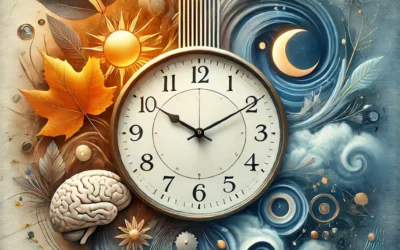In unseren früheren Blog-Beiträgen für Fachleute haben wir das Niveau der körperlichen Aktivität und Abweichungen im Schlafverhalten als eines der Hauptsymptome und Biomarker für affektive Störungen, insbesondere die bipolare Störung, erörtert. Gleichzeitig haben wir die möglichen Messmethoden für diese Parameter vorgestellt. Die Verwendung von aktigraphischen Sensoren scheint eine relativ einfache, für den Patienten leicht zu handhabende und vor allem genaue Methode zu sein, die die Funktion des zirkadianen Systems und die Aktivität des suprachiasmatischen Kerns (SCN) widerspiegelt [1] [2].
Darüber hinaus ist es mit den kontinuierlichen Fortschritten und Entwicklungen in der Digitaltechnik, bei Smartphones und mobilen Anwendungen möglich, diese Geräte für subjektive Patientenaufzeichnungen, objektive Messungen oder zur Visualisierung dieser Daten mit einer mobilen Anwendung zu nutzen. Es sind die digitalen Technologien, die eine objektivere Erkennung von Schlaf- und Bewegungsmusterabweichungen ermöglichen, die langfristig überwacht werden können und so den individuellen Krankheitsverlauf von affektiven Störungen oder den Fortschritt und die Wirksamkeit der Behandlung erfassen [3] [4].
Die mit Hilfe digitaler Technologien erhobenen objektiven Daten können in passive und aktive Daten unterteilt werden.
Die passive Überwachung der Patientenaktivität umfasst hauptsächlich aktigrafische Aufzeichnungen der Tages- und Schlafmuster. Aufgrund der Komplexität der aktigrafischen Datenanalyse empfehlen Schlafmediziner jedoch, diese Daten durch zusätzliche Informationen zu ergänzen. Zum Beispiel in Form von Schlaftagebüchern, um den Beginn des Schlafs und des Aufwachens genau zu bestimmen [6].
Smartphones und Armbänder sind auch in der Lage, Nutzerdaten zu sammeln. Dazu gehören Standortdaten über GPS, Aktivitäten in sozialen Medien, Anruf- oder Textnachrichtenprotokolle. Diese Arten von Informationen werden auch in Forschungsstudien empfohlen, um sie zu kombinieren und so ein umfassendes Bild des aktuellen Zustands des Patienten zu erhalten [7] [8].
Der Nachteil einer ausschließlich passiven digitalen Datenerfassung ist der Mangel an kontextbezogenen Informationen, die wiederum durch aktive digitale Aufzeichnungen ergänzt werden können. Die Ergänzung aktigrafischer oder anderer objektiver digitaler Daten durch eine subjektive Bewertung der Stimmungslage, des Niveaus kognitiver Prozesse oder von Lebensereignissen scheint am besten geeignet zu sein, um eine umfassendere und verständlichere Beschreibung des Zustands des Patienten zu ermöglichen. Psychologische Fragebögen, Selbstbewertungsskalen oder Stimmungstagebücher werden am häufigsten für diese subjektive Bewertung verwendet [9].
Inzwischen gibt es eine Reihe von Studien, in denen Selbsteinschätzungsskalen mit Aktigraphie oder anderen passiven Messinstrumenten wie Licht-, Temperatur-, galvanischen Hautreaktions- und Herzfrequenzsensoren kombiniert werden, um eine multimodale Überwachung der physischen und Umweltbedingungen zu ermöglichen, die Patienten mit bipolarer Störung unter den natürlichen Bedingungen des täglichen Lebens erfahren [5] [10].
So können Daten aus mobilen Apps die Echtzeitüberwachung von Gefühlsmustern, Verhalten, biologischen Rhythmen und anderen situativen Einflüssen erleichtern. Diese Ansätze wurden in großem Umfang angewandt, um die zugrundeliegenden Merkmale, Eigenschaften, Zustandsveränderungen und Auswirkungen der Behandlung bei bipolaren Störungen zu untersuchen.
Die Ergebnisse, die durch eine systematische Untersuchung aktueller digitaler Methoden gestützt werden, zeigen sichtbare Variationen im Schlaf, insbesondere eine längere Dauer und Variabilität der Schlafmuster, einen niedrigeren Mittelwert und eine größere Variabilität der motorischen Aktivität sowie eine Verlagerung der Spitzenaktivität und der Schlafmitte auf einen späteren Zeitpunkt. Die Entwicklung neuer funktioneller Analysewerkzeuge auf der Grundlage digitaler Daten kann dazu beitragen, tiefere Einblicke in die Mechanismen und die Dynamik der Manifestationen der bipolaren Störung zu gewinnen und dabei auch die umweltbedingten und physiologischen Korrelate der Störung zu berücksichtigen. Die digitale Technologie bietet ein großes Potenzial für die schnelle Identifizierung, Diagnose, longitudinale Nachverfolgung, Bewertung des klinischen Zustands oder Prüfung der Auswirkungen von Medikamenten [5] [11].
Seit 2016 entwickelt und verfeinert Mindpax ein umfassendes und personalisiertes System für Patienten mit bipolarer Störung und kombiniert die oben genannten Parameter in Forschungsstudien, um den aktuellen klinischen Status so genau wie möglich zu erfassen. Zunächst mussten wir die Validität der Aktigraphie-Daten [12] bei bipolaren Patienten sicherstellen und sie von gesunden Kontrollpersonen unterscheiden. Darüber hinaus haben wir im Laufe der Jahre die passiven digitalen Messungen mit einem aktigraphischen Sensor durch aktive digitale Daten mittels eines Stimmungsfragebogens ergänzt (ein von uns entwickelter und nach klinischen Stimmungsskalen validierter Fragebogen - ASERT) [13]. In der derzeit laufenden Studie wird das System zusätzlich um die Möglichkeiten der täglichen Selbsteinschätzung der Stimmung, der Erfassung wichtiger Lebensereignisse, die den Zustand des Patienten beeinflussen, der Erfassung der Medikamenteneinnahme und der Visualisierung aller subjektiven und objektiven Daten ergänzt. Darüber hinaus geben wir den Patienten nach einer Kalibrierungsphase der gesammelten Daten ein personalisiertes Feedback mit therapeutischen Elementen (d.h. eine digitale Therapie).
[1] Bauer M, Grof P, Rasgon N, Bschor T, Glenn T, Whybrow PC. Zeitlicher Zusammenhang zwischen Schlaf und Stimmung bei Patienten mit bipolarer Störung. Bipolar Disord. 2006 Apr;8(2):160-7
[2] De Crescenzo, F., Economou, A., Sharpley, A. L., Gormez, A., & Quested, D. J. (2017). Actigraphic features of bipolar disorder: A systematic review and meta-analysis. Sleep Medicine Reviews, 33, 58-69. https://doi.org/10.1016/j.smrv.2016.05.003
[3]Gershon, A., & Eidelman, P. (2015). Inter-episodische affektive Intensität und Instabilität: Predictors of depression and functional impairment in bipolar disorder. Journal of Behavior Therapy and Experimental Psychiatry, 46, 14-18. https://doi.org/10.1016/j.jbtep.2014.07.005
[4]Ducasse, D., Jaussent, I., Guillaume, S., Azorin, J. M., Bellivier, F., Belzeaux, R., ... & Albertini, L. (2017). Affektlabilität sagt das Auftreten von Suizidgedanken bei bipolaren Patienten voraus: eine zweijährige prospektive Studie. Acta Psychiatrica Scandinavica, 135(5), 460-469.
[5] Dunster, G.P., Swendsen, J. & Merikangas, K.R. Real-time mobile monitoring of bipolar disorder: a review of evidence and future directions. Neuropsychopharmacol. 46, 197-208 (2021). https://doi.org/10.1038/s41386-020-00830-5
[6]Ancoli-Israel S, Martin JL, Blackwell T, Buenaver L, Liu L, Meltzer LJ, et al. The SBSM guide to actigraphy monitoring: clinical and research applications. Behav Sleep Med. 2015;13:S4-S38.
[7]Gliddon E, Barnes SJ, Murray G, Michalak EE. Online- und mobile Technologien für das Selbstmanagement bei bipolarer Störung: eine systematische Überprüfung. Psychiatr Rehabil J. 2017;40:309-19. https://doi.org/10.1037/prj0000270.
[8]Faurholt-Jepsen M, Frost M, Ritz C, Christensen EM, Jacoby AS, Mikkelsen RL, et al. Daily electronic self-monitoring in bipolar disorder using smartphones - the MONARCA I trial: a randomized, placebo-controlled, single-blind, parallel group trial. Psychol Med. 2015;45:2691-704. https://doi.org/10.1017/S0033291715000410.
[9] Merikangas KR, Swendsen J, Hickie IB, Cui L, Shou H, Merikangas AK, et al. Mobile Echtzeitüberwachung der dynamischen Zusammenhänge zwischen motorischer Aktivität, Energie, Stimmung und Schlaf bei Erwachsenen mit bipolarer Störung. JAMA Psychiatry. 2019;76:190-8. https://doi.org/10.1001/jamapsychiatry.2018.3546
[10] Knell G, Gabriel KP, Businelle MS, Shuval K, Wetter DW, Kendzor DE. Ecological momentary assessment of physical activity: validation study. J Med Internet Res. 2017;19:e253.
[11] Orsolini, L., Fiorani, M., & Volpe, U. (2020). Digitale Phänotypisierung bei bipolarer Störung: Welche Integration mit klinischen Endophänotypen und Biomarkern? Internationale Zeitschrift für Molekularwissenschaften, 21(20), 7684. https://doi.org/10.3390/ijms21207684
[12] Schneider, J., Bakštein, E., Kolenič, M., Vostatek, P., Correll, C. U., Novák, D., & Španiel, F. (2020). Motorische Aktivitätsmuster können zwischen Inter-Episoden-Patienten mit bipolarer Störung und gesunden Kontrollpersonen unterschieden werden. CNS Spectrums, 1-32. https://doi.org/10.1017/S1092852920001777
[13]Anýž J, Bakštein E, Dally A, Kolenič M, Hlinka J, Hartmannová T, Urbanová K, Correll CU, Novák D, Španiel F
Validität des Aktibipo-Selbstbewertungsfragebogens zur digitalen Selbsteinschätzung der Stimmungslage und Rückfallerkennung bei Patienten mit bipolarer Störung: Studie zur Validierung des Instruments JMIR Ment Health 2021;8(8):e26348



